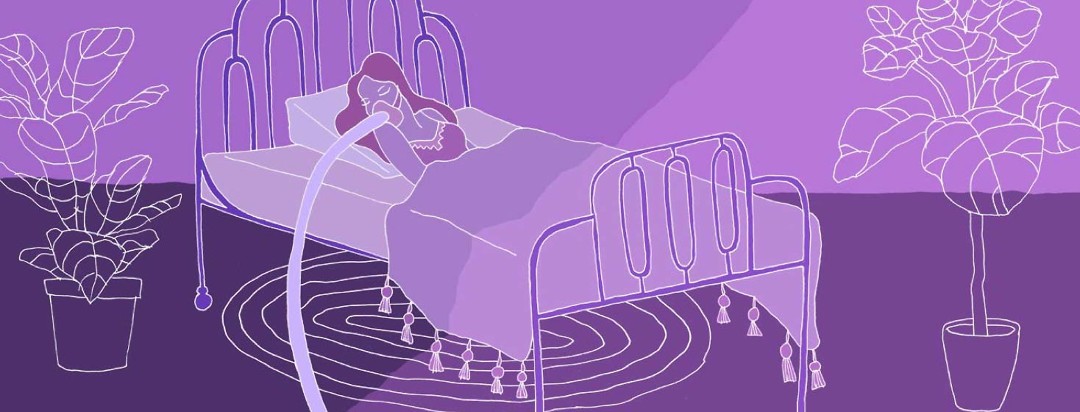New Year's Resolution: Make Your CPAP Therapy Work for You
Are you a brand-new user of continuous positive airway pressure (CPAP) and worried about this new nightly treatment?
Or are you, maybe, a CPAP dropout – someone who’s abandoned the therapy prescribed to treat your obstructive sleep apnea (OSA)?
Consider starting off the new year determined to make CPAP work for you.
Remember why you have CPAP
You were given this prescription in order to treat your OSA for a reason. It may be challenging to get used to, but face it: avoiding or abandoning it isn’t going to eliminate your sleep-breathing disorder.
Reality check – you’re not going to feel better and reclaim your health without treating your OSA.
Benefits of treating OSA
Obviously, the chief reason to treat OSA is to improve your sleep!
CPAP helps you breathe comfortably during sleep, taking in adequate oxygen while allowing you to rack up a full 7 to 8 hours of sleep. Your body and brain use sleep for repair and restoration. Untreated OSA generally leads to sleep deprivation, denying you these critical benefits.
Some things you’ll enjoy once you master PAP:1
- An end to daytime sleepiness and fatigue
- Reduced risks for critical workplace mistakes or accidents involving motor vehicles or heavy equipment
- Elevated mood, improved motivation, and improved well-being
- Lower blood pressure
- Longer life expectancy due to less chronic illness (heart disease, diabetes, stroke, etc.)
- Related to chronic illness: Spending less money and time in doctor’s offices and for medications or procedures related to untreated OSA
- Less chance for brain damage due to hypoxia (reduced blood oxygen) caused by frequent apneas every night
- More energy and focus applied to other new year’s resolutions like weight loss or smoking cessation
Other surprise benefits:2
- An improved relationship with your bed partner (they’ll also sleep better because you’re no longer snoring or gasping in your sleep)
- Pleasant side effects of breathing warm moist air (great for those with asthma or postnasal drip due to allergies)
- Improved memory for those at risk for dementia
Things to overcome in 2021
Resolutions acknowledge that challenges exist. Why not tackle these common CPAP obstacles in 2021?
Mask fit issues
It’s always good to start with prioritizing mask fit. Don’t be afraid to experiment until you find the mask that works best for you. Variables that go into selecting the right mask for your face shape and comfort level include:
- Size (from petite to extra-large)
- Style (nasal pillows, nasal mask, full-face mask)
- Mask design (various cushions, headgear)
- Pressure level (feels different in different masks)
- Mouth breathing (you may need a special mask type or chin support)
Your mask should “seat” to your face comfortably, without being too loose or too tight. It shouldn’t leave red marks on your face. And you should not experience leaking air. If you develop skin sensitivity to your mask, take comfort: barriers applied between the skin and the mask cushion can fix this.
You don’t have to try out masks alone. Your sleep doctor or equipment provider is happy to assist. They want you to succeed! Insurance may or may not cover more than 2 or 3, but your investment in CPAP will be worth this extra cost and effort.
Machine and tubing issues
Maybe it’s not the mask that bothers you. Maybe you can’t tolerate the air pressure your doctor has prescribed. Are you waking up feeling bloated and gassy? Or do you feel like you’re suffocating? Maybe you despise humidity, or you wake up with dry passages because you’re not getting enough humidity.
Another problem might be condensation in the mask cushion. Known as “rainout,” it can be unpleasant. This is another problem that can be fixed. Also: While using CPAP, if you’ve found yourself getting sinus infections, frequent head colds, or contact dermatitis, you might not be keeping your mask and equipment adequately maintained. A quick lesson in cleaning CPAP may be all you need to do.
Fear of the unknown
Many people new to CPAP automatically believe they won’t tolerate treatment because they fear the idea of something on their face. However, others who presumed this gave it a shot anyway and discovered CPAP wasn’t as bad as they expected. They simply got used to it. You can, too!
But keep expectations realistic. It can take several weeks, even months, to fully master CPAP. Once you achieve this, its benefits become apparent. Perhaps the most legitimate testimony you’ll find comes from the many who swear by CPAP and won’t sleep without it.
If you continue to experience anxiety or claustrophobia while using PAP, contact your sleep doctor. Don’t be ashamed if CPAP hasn’t worked. While it’s an effective OSA therapy, it’s not the only one. Oral devices, neurostimulator implants, and surgical procedures are other options to consider.
Is one of your New Year's resolutions about your CPAP? Share with the community in the comments below.
Community Poll
Do you feel that people living with you have been affected by your sleep apnea symptoms?

Join the conversation